Nature and Sources of the Pollutant
 Particulate matter is the general term used for a mixture of solid
particles and liquid droplets found in the air. Some particles are
large enough to be seen as dust or dirt. Others are so small they
can be detected only with an electron microscope. PM2.5
describes the “fine” particles that are less than or equal to 2.5
µm in diameter.“Coarse fraction” particles are greater than 2.5 µm,
but less than or equal to 10 µm in diameter. PM10
refers to all particles less than or equal to 10 µm in diameter (about
one-seventh the diameter of a human hair). PM can be emitted directly
or formed in the atmosphere. "Primary"particles, such as
dust from roads or black carbon (soot) from combustion sources, are
emitted directly into the atmosphere. "Secondary"particles
are formed in the atmosphere from primary gaseous emissions. Examples
include sulfates formed from SO2 emissions from power plants and industrial
facilities; nitrates formed from NOx emissions from power plants,
automobiles, and other combustion sources; and carbon formed from
organic gas emissions from automobiles and industrial facilities.
The chemical composition of particles depends on location, time of
year, and weather. Generally, coarse PM is composed largely of primary
particles and fine PM contains many more secondary particles.
Particulate matter is the general term used for a mixture of solid
particles and liquid droplets found in the air. Some particles are
large enough to be seen as dust or dirt. Others are so small they
can be detected only with an electron microscope. PM2.5
describes the “fine” particles that are less than or equal to 2.5
µm in diameter.“Coarse fraction” particles are greater than 2.5 µm,
but less than or equal to 10 µm in diameter. PM10
refers to all particles less than or equal to 10 µm in diameter (about
one-seventh the diameter of a human hair). PM can be emitted directly
or formed in the atmosphere. "Primary"particles, such as
dust from roads or black carbon (soot) from combustion sources, are
emitted directly into the atmosphere. "Secondary"particles
are formed in the atmosphere from primary gaseous emissions. Examples
include sulfates formed from SO2 emissions from power plants and industrial
facilities; nitrates formed from NOx emissions from power plants,
automobiles, and other combustion sources; and carbon formed from
organic gas emissions from automobiles and industrial facilities.
The chemical composition of particles depends on location, time of
year, and weather. Generally, coarse PM is composed largely of primary
particles and fine PM contains many more secondary particles.
Health and Environmental Effects
Particles that are small enough to get into the lungs (those less than or equal
to 10 µm in diameter) can cause numerous health problems and have
been linked with illness and death from heart and lung disease. Various
health problems have been associated with long-term (e.g.,multiyear)
exposures as well as daily and, potentially, peak (e.g., 1-hour) exposures
to particles. Particles can aggravate respiratory conditions such
as asthma and bronchitis and have been associated with cardiac arrhythmias
(heartbeat irregularities) and heart attacks. Particles of concern
can include both fine and coarse-fraction particles, although fine
particles have been more clearly linked to the most serious health
effects. People with heart or lung disease, the elderly, and children
are at highest risk from exposure to particles.
In addition to health problems, PM is the major cause of reduced
visibility in many parts of the United States. Airborne particles
also can impact vegetation and ecosystems and can cause damage to
paints and building materials. (See sections on Acid
Rain, NO2, and SO2.)
Trends in PM10 Levels and Direct Emissions
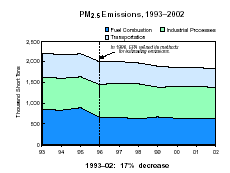

|
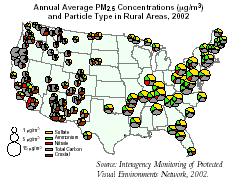
 Note: Direct comparisons of the information in these two maps should
take into consideration the fact that one is a rural network and the other
is an urban network and that there are differences in instruments and
measurement methods.
Note: Direct comparisons of the information in these two maps should
take into consideration the fact that one is a rural network and the other
is an urban network and that there are differences in instruments and
measurement methods.
|
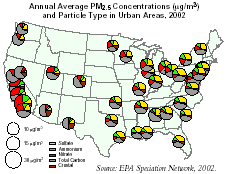

|
|
If enacted, President Bush’s Clear Skies Initiative would
decrease PM concentrations by dramatically reducing
emissions of SO2 and NOx. This initiative would also
reduce mercury emissions (www.epa.gov/clearskies).
|
Between 1993 and 2002, average PM10 concentrations
decreased 13 percent, while direct PM10
emissions decreased 22 percent.
Trends in PM2.5 Levels and Direct Emissions
The chart at left shows that direct PM2.5 emissions
from man-made sources decreased 17 percent nationally between 1993
and 2002. This chart tracks only directly emitted particles and does
not account for secondary particles, which typically account for a
large percentage of PM2.5. As discussed
previously, the principal secondary particles are sulfates, nitrates,
and organic carbon.
The maps at left show how sulfates, nitrates, and total carbon
(black carbon and organic carbon) along with other components, contribute
to PM2.5 concentrations. The first
map represents the most recent year of data (September 2001-August
2002) available from the Interagency Monitoring of Protected Visual
Environments (IMPROVE) network, which was established in 1987 to
track trends in pollutants, such as PM2.5,
that contribute to visibility impairment. Because the monitoring
sites are located in rural areas throughout the country, the network
is a good source for assessing regional differences in PM2.5.
The second map represents the most recent year of data (September
2001–August 2002) from EPA’s urban speciation network, which was
established in 1999. All of these sites are located in urban areas.
The IMPROVE data show that PM2.5 levels in
rural areas are highest in the eastern United States
and southern California, as shown by the larger
circles. Sulfates and associated ammonium dominate
the East, with carbon as the next most prevalent
component. Sulfate concentrations in the East
largely result from SO2 emissions from coal-fired
power plants. In California and other areas of the
West, carbon and nitrates make up most of the
PM2.5 measured.
The urban speciation data show that sites in urban
areas, as shown in the circles in the map at right,
generally have higher annual average PM2.5
concentrations than nearby rural areas. Urban sites
in the East include a large percentage of carbon
and sulfates (and ammonium). Urban sites in the
Midwest and far West (and especially in California)
include a large percentage of carbon and nitrates.
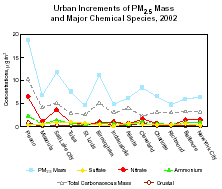
 Source: Interagency Monitoring of Protected
Visual Environments
Source: Interagency Monitoring of Protected
Visual Environments
Network and EPA Speciation Network, 2002.
|
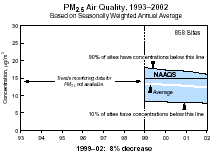

|
The lines in the figure above display West-to-East urban increments of PM2.5 levels
and the major chemical constituents. EPA compared the annual average
PM2.5 concentration at each of these 13 sites with measurements from
a nearby rural site. The urban excess shown above illustrates the
difference in concentrations from these paired sites. In general,
the single largest component of urban excess is total carbonaceous
material. There is little or no excess of sulfates (confirming the
regional nature of this pollutant) and only moderate urban excess
of nitrate at some locations. The components of PM2.5 showing urban
excesses come from sources local to the urban area. This illustrates
the importance of local, metropolitan area controls in addition to
regional control programs.
In 1999, EPA and its state, tribal, and local air pollution control
partners deployed a monitoring network to begin measuring PM2.5
concentrations nationwide. Now that there are several years of monitoring
data available, EPA has begun to examine trends at the national
level. Annual average PM2.5 concentrations decreased 8 percent nationally
from 1999 to 2002. Much of that reduction occurred in the Southeast
where the monitored levels of PM2.5 decreased 18 percent from 1999
to 2002. Lower annual average concentrations in the Southeast can
be attributed, in part, to decreases in sulfates, which largely
result from power plant emissions of SO2.
PM2.5 concentrations vary regionally. Based on the monitoring
data, parts of California and many areas in the eastern United States
have annual average PM2.5 concentrations above the level of the
annual PM2.5 standard. With few exceptions, the rest of the country
generally has annual average concentrations below the level of the
annual PM2.5 health standard.
Because of health effects associated with short-term exposure to PM2.5, daily
levels are also of concern. Actual and forecasted daily air quality
is assessed and reported using EPA’s Air Quality Index (AQI).The
forecasted AQI is typically featured in USA Today and on The Weather
Channel, as well as in local media. In the summertime, ozone is
usually the pollutant of concern on days when the air is unhealthy.
But PM2.5 also plays a role in unhealthy air quality in the summertime
in some regions, even on days when the ozone levels are not high.
PM2.5 is also responsible for days with unhealthy air in cooler
months. Because of its complex chemical makeup, PM2.5 levels can
be in the unhealthy range any time during the year (sulfates are
usually higher in the summer; carbon and nitrates, in the winter).
Many major metropolitan areas are beginning year-round reporting
and forecasting of AQI values through the incorporation of daily
PM2.5 information.
More Details on Particulate Matter
|

